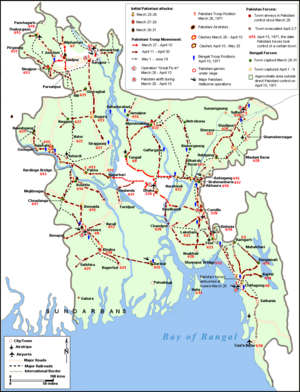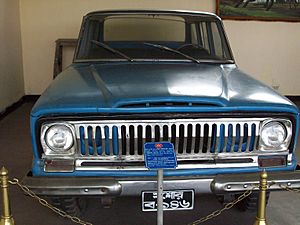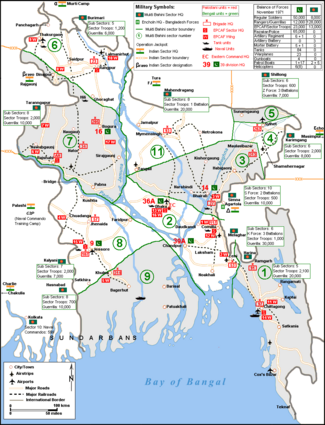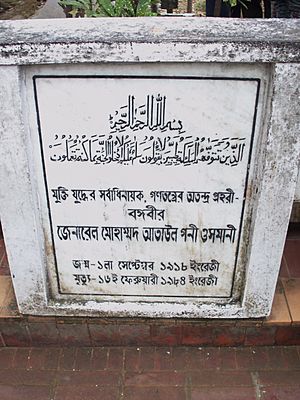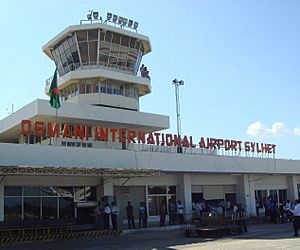M. A. G. Osmani facts for kids
Quick facts for kids
General Bangabir
বঙ্গবীর M. A. G. Osmani
|
|
|---|---|
| Native name |
মুহাম্মদ আতাউল গণি ওসমানী
|
| Nickname(s) | Bongobir (বঙ্গবীর) |
| Born | 1 September 1918 Sunamganj, Sylhet district, Assam Province, British India |
| Died | 16 February 1984 (aged 65) London, United Kingdom |
| Buried |
Shah Jalal Dargah Cemetery
Sylhet, Bangladesh |
| Allegiance | |
| Service/ |
|
| Years of service |
|
| Rank |
|
| Commands held |
|
| Battles/wars | |
Muhammad Ataul Goni Osmani (Bengali: মুহাম্মদ আতাউল গণি ওসমানী; 1 September 1918 – 16 February 1984) was a brave Bengali military leader. He was also known as Bangabir (meaning "Hero of Bengal"). Osmani's long career in the army started in 1939. He served in the British Indian Army and fought in World War II.
After India was divided in 1947, he joined the Pakistan Army. He later retired as a colonel in 1967. In 1971, Osmani became the commander-in-chief of the Bangladesh Forces. These forces fought for Bangladesh's independence. He is seen as the founder of the Bangladesh Armed Forces. Osmani retired as a four-star general from the Bangladesh Army in 1972.
After the war, Osmani became a politician in independent Bangladesh. He served as a Member of Parliament and a government minister. He passed away in London in 1984 and was buried in his hometown of Sylhet.
Contents
Early Life and Education
Osmani was born in Sunamganj, which was then part of British India, on September 1, 1918. His family owned land in the area. He was a descendant of Shah Nizamuddin Osmani, a famous person from the 14th century. His family village is in Osmani Nagar Upazila in Sylhet District.
Osmani went to school in Sylhet. He finished high school in 1934. He was very good at English and even won a special prize for it. He later studied geography at Aligarh Muslim University and graduated in 1938. The next year, he joined the Indian Military Academy to become an army officer.
Military Career
Osmani joined the British Indian Army in 1939. He became a second lieutenant in 1940. He was sent to Burma during World War II. There, he served in the XV Corps.
Serving in the British Indian Army (1941–1947)
Osmani quickly moved up in rank. He became a temporary captain in 1941 and an acting major in 1942. Between 1941 and 1945, he held several important roles. These included leading platoons and companies.
In 1946, Osmani became a regular captain in the British Indian Army. He was promoted to lieutenant colonel in 1947. He worked at the British Indian Army Headquarters in Shimla. Even though he passed an exam for a foreign service job, he chose to stay in the army. He helped divide the army's resources between India and Pakistan when they became separate countries.
Joining the Pakistan Army
After India and Pakistan became independent in 1947, Osmani joined the new Pakistan Army. He was promoted to acting lieutenant colonel in 1948. He worked at the general staff headquarters.
Osmani also attended the Pakistan Command and Staff College in Quetta. After his training, he worked for the army chief of staff. He suggested creating cadet colleges in East Pakistan (which is now Bangladesh).
Leading Bengali Regiments
After eight years as a staff officer, Osmani joined the infantry. He became a major and was posted to the 5th Punjab Battalion. In 1951, he became the commander of the 1st East Bengal Regiment. He was the first Bengali officer to lead this regiment.
Osmani wanted to promote Bengali culture in the army. He chose Bengali songs for the regiment's marching and band. He also made his non-commissioned officers (NCOs) write daily reports in Bangla. Some of his Punjabi superiors did not like this. They thought he was bringing in "Hindu" culture. From 1953 to 1955, he was the commandant of the East Bengal Regimental Center in Chittagong. He also worked to recruit more non-Bengali minority groups into the army.
Efforts for Bengali Soldiers
Osmani was promoted to lieutenant colonel in 1955. He worked at the Pakistan Army Headquarters in Rawalpindi. He became a colonel in 1961. Even though he was a high-ranking officer, he felt that Bengali soldiers were not treated fairly.
After 1947, there were very few Bengali officers and soldiers in the Pakistan armed forces. The British had preferred to recruit from certain groups. Many Pakistani officers also believed that Bengalis were not good soldiers. They thought Bengalis were too small and did not meet physical requirements. Osmani worked hard to improve the situation for Bengali troops. He was known as "Papa Tiger" by Bengali soldiers.
Retirement and Continued Influence
Osmani retired from the Pakistan Armed Forces on February 16, 1967. Even though he retired, his efforts helped. The Pakistani high command later increased the number of Bengal regiments. They also ordered that at least 25 percent of new recruits should be Bengali.
Political Activity
After retiring from the army, Osmani entered politics in East Pakistan. He joined Sheikh Mujibur Rahman's All Pakistan Awami Muslim League in 1970. He was elected to the national assembly from Sylhet. However, he did not serve in the Pakistani assembly. This was because the Bangladesh War of Independence began, and he joined the provisional government of Bangladesh.
Bangladesh War of Independence
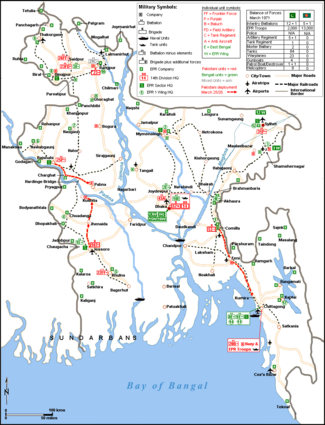
In 1971, Osmani became a military advisor for the Awami League leaders. As the political situation got worse, many Bengali officers looked to their leaders for guidance. Osmani helped coordinate secret meetings among Bengali military officers. He advised officers to be careful and avoid hasty actions.
Operation Searchlight
Before the Pakistani army crackdown, Bengali students and youth were training volunteers. The Awami League declared independence on March 7, 1971. Bengali ex-soldiers held rallies to support independence. Bengali officers warned that the Pakistan Army was getting ready to attack. However, these warnings were not fully heeded.
The Pakistan Army launched Operation Searchlight on March 25, 1971. This operation surprised many Bengali leaders and soldiers. The resistance was not well organized at first. Most Awami League leaders fled to Calcutta. Bengali soldiers rebelled only when they were attacked or heard news of the Pakistani attack.
Osmani was at Sheikh Mujibur Rahman's home when the army movements were reported. After Rahman refused to hide, Osmani hid in Dhaka. He later made his way to the Indian border, reaching India by April 2, 1971.
Meetings at Teliapara
On April 2, 1971, Osmani arrived at Teliapara. Here, the 2nd and 4th East Bengal Regiments had set up a temporary base. He held a meeting with Bengali officers on April 4. They discussed military plans.
At another meeting on April 7, Osmani appointed five sector commanders. These commanders would lead the fight in different areas. The officers also agreed that a government in exile should be formed. This would show that their fight was not just a military revolt. On April 12, the Bengali government in exile appointed Osmani as the commander of the Mukti Bahini. When the Bangladesh government was officially formed on April 17, 1971, he became the commander-in-chief.
Early Activities as Commander-in-Chief
After April 17, 1971, Osmani took command of the Mukti Bahini. It was hard to command all forces because they were spread out and lacked communication. Osmani let the sector commanders fight as they thought best. He traveled to meet with Indian officials to get weapons and communication help.
The Bengalis fought back strongly, which surprised the Pakistanis. But the Bengalis lacked trained soldiers, officers, and supplies. The Pakistani Army brought in more troops and began to take control. Their plan was to clear cities, secure transport routes, and push the rebels out.
Bengali commanders decided to hold onto as much land as possible. The government in exile hoped to gain international recognition. They also prepared for guerrilla warfare and waited for India to help.
Indian Involvement
After the crackdown, Bengali leaders asked Indian Prime Minister Indira Gandhi for more help. India's border forces were already giving some aid.
Indian military leaders said their army would not be ready for a full intervention until November. So, the Indian government decided to get involved without directly intervening at first. They began to arm, train, and advise the Mukti Bahini.
Rebuilding the Mukti Bahini
From April to June, Osmani visited troops to boost their spirits and gather information. He also met with Indian officers and set up the Bangladeshi command structure. By mid-June, Bengali soldiers were pushed into India. There, they built up their forces for a long guerrilla campaign.
In July, a meeting of sector commanders was held. Osmani had briefly resigned but returned to his post. The meeting decided on the Mukti Bahini's structure and roles. Bangladesh was divided into 11 combat sectors. Osmani remained commander-in-chief.
The Mukti Bahini had two main parts: regular forces and freedom fighters. Regular forces were made up of Bengali soldiers who had left the Pakistan Army. Freedom fighters were mostly new recruits. They were sent into Bangladesh to fight.
Strategy for the Campaign
Osmani made important strategy decisions and worked with Indian officers. His strategy was shaped by his military background and the situation on the ground. He had served in Southeast Asia during World War II.
On May 15, the Indian Army began helping to build the liberation force. Osmani and Khaled Musharraf wrote a paper on war strategy. They planned to train 30,000 regular soldiers and 70,000 guerrillas.
July–September 1971
Osmani was a traditional soldier. His first plan was to build a strong conventional army. He wanted to use this army to free an area around Sylhet. Guerrilla warfare across the country was a secondary goal. The Bangladesh government asked him to use the many available volunteers. So, he agreed to send thousands of guerrillas into Bangladesh with basic training.
Indian planners helped create more battalions and artillery units. They also stressed the importance of guerrillas. Osmani agreed. In July, the Mukti Bahini began sending 2,000-5,000 guerrillas into Bangladesh each month. They planned to increase raids and ambushes. They also aimed to destroy power stations, railway lines, and bridges to weaken Pakistani forces.
Action and Reaction (June–September)
After pushing the Mukti Bahini out of Bangladesh by May 1971, the Pakistan army had some peace in June and July. Mukti Bahini activity was low during this time. The Indian army started shelling border posts to help infiltrators. Bengali regular forces were not ready until mid-July.
The Pakistani Eastern Command reorganized its forces to control the province. They created a new force called the East Pakistan Civil Armed Force. This force was made up of West Pakistani and Bihari volunteers, plus local groups like Razakars. These units took over border control and internal security.
Monsoon Offensive
Mukti Bahini activity increased in June. The Pakistan Army used Razakars and the EPCAF to fight them. They also built an intelligence network. Bengali regular forces attacked Pakistani border posts with mixed results. Pakistani authorities thought they had stopped the "Monsoon Offensive."
Osmani reviewed Mukti Bahini activities from June to August. He found that their network was not strong enough. Many guerrillas had to retreat under Pakistani pressure. The Mukti Bahini also had supply problems. The attacks by Bengali regular troops had mixed results.
Because the Monsoon Offensive did not fully succeed, the Bangladeshi high command had to rethink their strategy. Osmani considered changing the structure of his forces.
Leadership Style
Osmani did not try to control every small detail. He gave responsibility to his sector commanders. This was partly because of the distance and lack of direct communication. He lived a simple life during the war. He wore simple clothes, ate soldiers' food, and used basic furniture. He wanted to set an example for his men.
He was firm when dealing with Indian officers. As commander-in-chief, Osmani's position was equal to India's top general. He was known for being stubborn. However, he was also practical and did not let rules stop the war effort.
Osmani sometimes criticized his officers in public. He also talked about the future Bangladesh army during his visits to the front. He believed that officers should be chosen based on their skills, not their politics. At first, only Awami League members were recruited for the Mukti Bahini for security reasons. But in September, Osmani opened recruitment to anyone willing to fight for Bangladesh.
He used his position to his advantage. If there was a problem, he would sometimes threaten to resign to get things moving.
Death and Legacy
In 1983, when he was 65, Osmani was diagnosed with cancer. He was flown to London for treatment. He died on February 16, 1984. Osmani's body was brought back to Bangladesh. He was buried with full military honors next to his mother's grave in Darga, Sylhet.
Osmani, known as bongobir (Hero of Bengal), played a huge role in organizing the Bangladesh armed forces. Many places are named after him to honor his contributions. The international airport in his hometown, Sylhet, is called Osmani International Airport. The MAG Osmani Medical College and the city's main hospital also bear his name. There is also an Osmani Memorial Auditorium in Dhaka and the Osmani Museum in Sylhet.
See also


